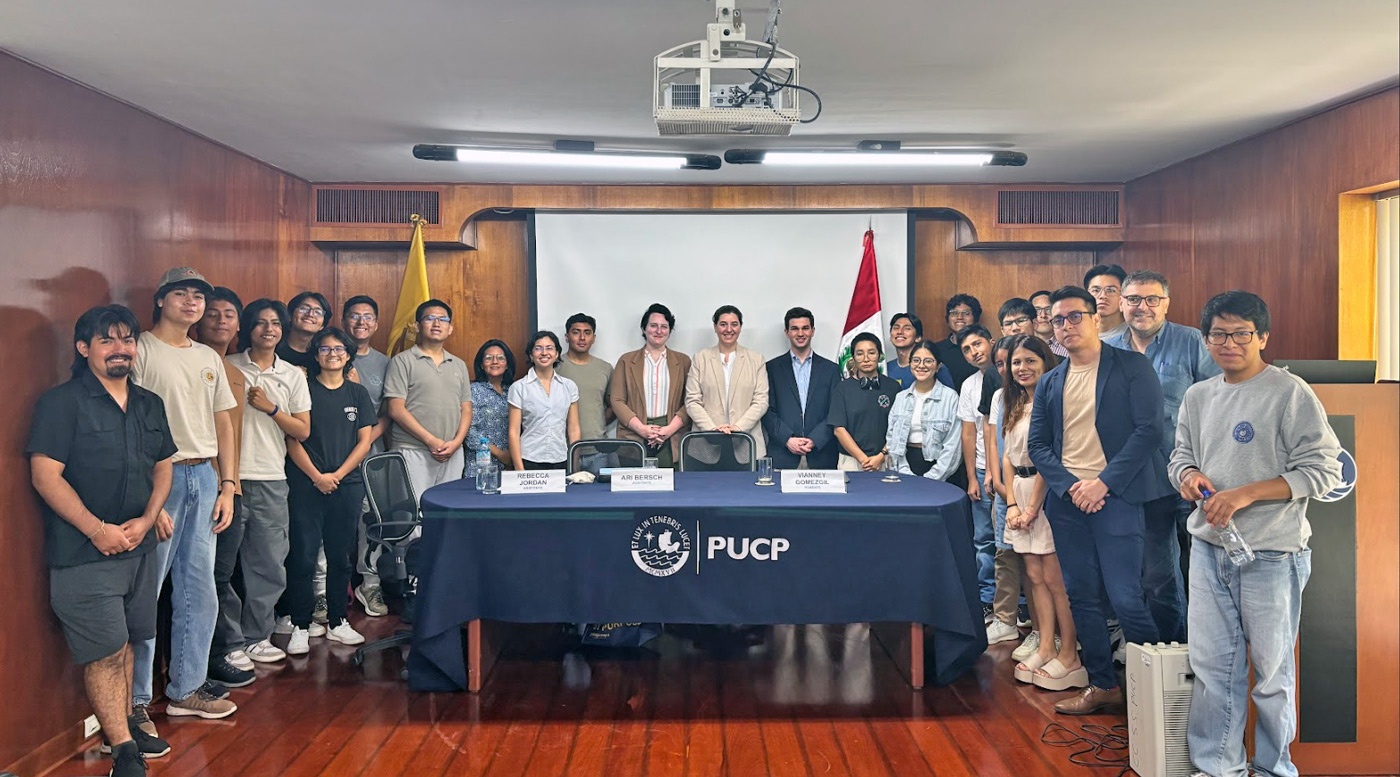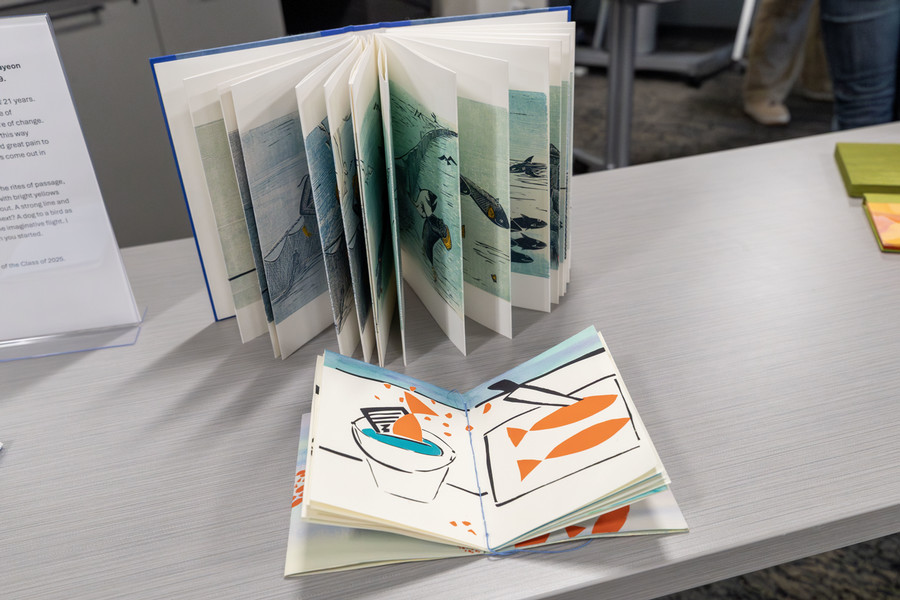Students Use Art, Technology, and Design to Address Public Transportation and Affordable Housing Challenges
By Rebecca GoldfineStudents from Art, Technology, and Design for Social Change will present their community-engaged projects, in collaboration with Avesta Housing and Catholic Charities Refugee and Immigration Services, on Tuesday, May 8, at 4 p.m., in Hubbard Hall’s Shannon Room.
Students in a new Digital and Computational Studies class called Art, Technology, and Design for Social Change collaborated this semester with two nonprofits to come up with creative solutions to challenges confronting marginalized populations in Maine.

Last February, professor Erin Johnson invited representatives from Catholic Charities and Avesta Housing to her class to describe some of the everyday difficulties facing their clients. Catholic Charities supports, among other populations, newly arrived immigrants and refugees to Portland, and Avesta provides affordable housing in Maine and New Hampshire. Johnson requested that the guests pose “open-ended challenges” rather than spell out specific needs.
Although her main vocation is art, Johnson — a visiting professor of art and digital and computational studies — also has a background in community organizing. “I am really invested in the idea of connecting teaching with the larger community, and opening the classroom,” she said. “This class allows everyone to have that experience, both learning more about the state they’re living in and contributing to the social justice work that is happening here.” (Johnson was recently recognized for her community-engaged classes by Maine Compass Compact.)
Contemporary Problems
Greg Payne, a development officer for Avesta Housing, visited Johnson’s class along with the organization’s president and CEO, Dana Totman. “One of the things we always keep in mind here is you only benefit when people get a fresh look at your issue and new creative minds examine what is happening with an eye toward what can be done better or differently,” he said.
He and Totman spoke about Avesta Housing’s struggle to create enough apartments to meet the demand for affordable housing, forcing the organization to put many people on waiting lists. They asked students to come up with a way their clients can share their stories and channel their frustrations to help bring about change. “So that people who come to us, call us, and who are unable to get help — as well as their allies — could use the tool to advocate for greater investments in affordable housing,” Payne said. “People are frustrated and when people are frustrated, it’s important for legislators to hear that.”
Catholic Charities Refugee and Immigration Services program director Hannah DeAngelis spoke to students about how Portland’s current public transportation system can impede refugees’ attempts to find and keep jobs. “There are only certain jobs for people who speak limited English and many are not accessible by bus routes,” she said. “The impact of not having access to transportation has a big effect on how they can be self-sufficient members of our community.”
Additionally, many of Catholic Charities’ clients are unfamiliar with public transportation, so navigating a new city’s bus system can be a nerve-wracking prospect. DeAngelis asked the students to come up with a means of making public transit appear more accessible and welcoming, while keeping in mind that many new Mainers are still learning English.
After listening to these two pitches, the students broke into four teams, two teams per organization.
Contemporary solutions
Before the students began their work, Johnson taught them lessons on design, media theory, public art, and how to collect, analyze, and present data. Students learned new tools, including ArcGIS, Shiny, InDesign, and Final Cut Pro X.
Avesta Housing: One group working with Avesta has built a “roving” mailbox emblazoned with the phrase, “no place like home.” In its side is an iPad featuring a video — that students shot and edited — of people who have found housing through Avesta talking about their new home and what it means to them. The students also designed postcards addressed to lawmakers for the general public to fill in and drop into the mailbox. The postcards will be sent to both of Maine’s U.S. senators, Susan Collins and Angus King, and to Gov. Paul LePage. The mailbox is on wheels and will rove among four locations: Longfellow Books in Portland, Portland Public High School, Portland Public Market, and Bowdoin’s Hawthorne-Longfellow Library.




The other Avesta group created data visualizations representing the disparity between average rents for city apartments and the minimum wage. The data visualizations will be published on a website the students design and projected onto the window of Avesta Housing’s main office in downtown Portland. Their website also contains stories of people who are waiting for a new home, and an action page for these people to share their stories with elected officials.
After interviewing Avesta staff, Carly Berlin ’18 said her group decided that education was critical. “Often people blame the homeless [for not having a home],” she said. “But there are much larger social problems and structural causes contributing to it.”
Hailey Beaman ’18, who is also part of this group, said she was astonished to learn about the scope of Maine’s homelessness. “We wanted to find a way to make the data and statistics that illustrate the problem more humanized,” she said. She added that she took the class because she’s “interested in the more radical potentials of technology, in terms of creating space and giving voice to people who might be marginalized.”
Berlin, and English major and art history minor, said she enrolled in the class to “do something really outside my regular writing and reading routine.” She added, “It’s been a lesson in using my creativity and critical thinking and research abilities in a different way. And it also feels very practical.”
Catholic Charities: One group working with Catholic Charities is using ArcGIS Story Maps to show the disconnect between where new Mainers live and the locations of companies that hire them, as well as the lack of buses that run during the night shifts some refugees work. Their group’s tool, said Ally Fromson-Ho ’19, could help nudge employers to set up car pools for their employees, or get more people in the city thinking about plotting different bus routes.
“This class teaches you real work skills, real world skills,” Fromson-Ho said. An environmental studies and history major, and visual arts minor, she is interested in urban planning and environmental design and said she took the class to get more experience using and applying technology. “A lot of environmental issues center around transportation, and raising awareness about transportation and improving transportation can either accentuate the problems or reduce them,” she said.








Dankens, a visual arts and math major, signed up for Johnson’s class because it “addressed the fundamentals of design in a liberal arts environment,” an interest that reflects her desire to pursue a career in architecture and design. While she’s taken many courses here on architectural history and the visual arts, she said she appreciated the chance to take a class that makes “more contact with the practical applications of design.”
A valuable part of the class, she added, has been trying out ideas and seeing them fail — despite this being uncomfortable at times. “There is something so refreshing in doing concrete design work that will be implemented for an existing community…, which makes adaptation from failure even more crucial to the process,” she wrote in an email. “My group has encountered so many dead ends with our project over the course of the semester, and so we’ve adapted.”
She continued: “I don’t think I would have really engaged with the steps of design thinking were it not for the hardships we came across throughout the process. I see this class as real-life introduction to the kind of experiences I will experience in the fields I seek to go into.”



